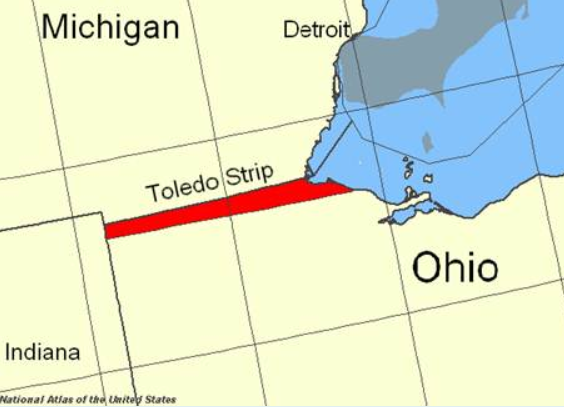The Toledo War was a territorial dispute that took place in the early 19th century, and it had far-reaching consequences for the future of the United States. The disagreement centered around a narrow strip of land known as the Toledo Strip, located between the state of Ohio and the territory of Michigan. Both Ohio and Michigan claimed the region as part of their respective territories, leading to a heated conflict that would eventually be resolved through negotiation and congressional intervention.
The root cause of the Toledo War can be traced back to conflicting interpretations of the Northwest Ordinance of 1787, which established guidelines for the organization of new territories in the region. Michigan argued that the northern boundary of Ohio should be an east-west line drawn from the southernmost point of Lake Michigan. However, Ohio maintained that its northern boundary was a line due east from the southernmost point of Lake Michigan. This discrepancy led to the overlapping claim of the Toledo Strip, an area rich in resources and strategically important for both states.
Tensions escalated in the late 1830s when both Ohio and Michigan began asserting their authority over the disputed region. Confrontations between surveyors, militias, and civilians became common, and at times the situation appeared on the brink of open warfare. However, a series of negotiations, led in part by President Andrew Jackson, aimed at preventing armed conflict and finding a peaceful resolution.
In 1836, Congress stepped in to resolve the dispute. It offered Michigan statehood on the condition that it relinquish its claim to the Toledo Strip in favor of Ohio. Additionally, Congress granted Michigan the Upper Peninsula, which was later found to be rich in copper and iron ore, compensating the state for its territorial loss. In June 1837, Michigan accepted the proposal, and the Toledo War came to an end without any shots being fired.
The resolution of the Toledo War had a profound impact on the nation’s future. Ohio’s borders were officially recognized, and Michigan joined the Union as the 26th state on January 26, 1837. The conflict also highlighted the importance of clarifying territorial boundaries and spurred Congress to be more precise in the establishment of state borders in the future. Moreover, the Toledo War showcased the effectiveness of diplomacy and negotiation in resolving disputes, setting a precedent for peaceful conflict resolution in other parts of the country.
In conclusion, the Toledo War was a significant event in American history that underscored the complexities of defining territorial boundaries during the nation’s westward expansion. It demonstrated the importance of clear and well-defined borders and the necessity of diplomatic solutions to prevent unnecessary bloodshed. Ultimately, the Toledo War played a crucial role in shaping the development of Ohio and Michigan and helped lay the groundwork for future boundary disputes in the United States.


